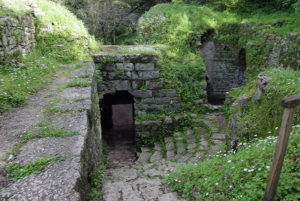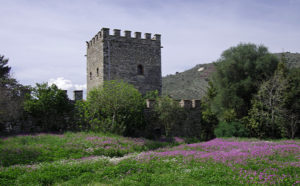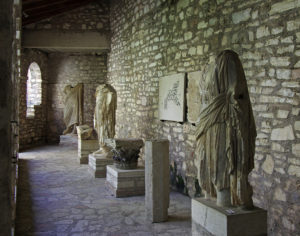This follow on from my other review describing the history and the site. Butrint is a World Heritage Site covering 200 years of occupation and evidence from all the early inhabitants is still there to see. This review describes some of the things to enjoy on a visit. It is probably the most visited site in Albania and deservedly so. It is wonderful.
Near the entrance is a Venetian Watch Tower which was built in the C16th to protect the fishing grounds. The path leads through the trees and past a small community run shop selling locally made handicrafts in the sumer months.
Beyond is the original C7th BC settlement with the ruins of the Shrine of Ascepius and the theatre. This area flooded when the water table rose and small terrapins can be seen around the stones. There were at least two shrines here. One was set back into a cleft in the rock and acted as a treasury where pilgrims could leave donations.
Beyond is the theatre and is one of the best preserved in Albania. It dates from the C3rd BC and the seats were cut out of the hillside. The lowest row of seats were reserved for magistrates and leading citizens. It is worth climbing up the steps for the top for the views.
The stone orchestra is now flooded and is covered by a wooden stage. The three arched scena allowed actors to move around the stage. The niches would have contained statues. When the site was excavated in the 1930s, many broken pieces of statues were found. When Butrint fell out of use, the marble statues were broken up and burnt to produce high quality lime for mortar.
Behind the scena are the remains of Roman buildings, including a bath house with part of a restored hypocaust. Beyond is the site of the forum, which was built on the site of the Greek Agora. The area was badly damaged in the C4th earthquake and abandoned. It is now a grassed area with bumps indicating buried masonry. UNESCO will not allow further excavation. Along the back wall are three small faltoret shrines. To the left of them, a paved track leads to the Pusi sacred well, dating from the C4th BC.
Beyond the forum is the gymnasium, which was a training area. It later had a Roman villa built on it with a small C5/6th chapel.
Through the trees beyond this is the baptistry. This is dated from its mosaic floor as being built between 550-575 AD. It is one of the largest and most elaborate in the mediterranean area with a double row of columns were re-erected in the 1930 and would originally have supported an arcade around the central lantern which allowed light down onto the font. The water was heated by a hypocaust system and then piped under the mosaic floor to the font. The wonderful “mosaic floor”:https://upload.wikimedia.org/wikipedia/commons/thumb/b/b1/Mosaic_of_Butrint_Baptistery.jpg/1200px-Mosaic_of_Butrint_Baptistery.jpg is kept covered with sand to protect it.
Beyond the baptistry is the basilica which was built in the C6th is one of the best preserved late antique period basilicas in Albania. It has been rebuilt at least twice and the walls stand to nearly their original height. It was a three aisled building. The apse and nave were used by the priests and there would have been a nave pulpit. The aisles were used by the congregation with the small transepts reserved either for the clergy or wealthy patrons who paid for the privilege to be near the altar.
A path leads down to the Lake gate which is a typical Hellenic gate giving access to the shore of Lake Butrint. The wall here is C4th BC and constructed from massive stones without the use of mortar. The plumb line cut into the corner of the wall may either have acted as a drain for rainwater or ensured the straight arrangement of the blocks.
The path runs along the outside of the wall to the Lion Gate. This was originally a Hellenic gate like the Lake Gate but was altered in the middle ages when a tower was added. The name comes from the carving over the lintel of a lion attacking a bull. The bull is on the ground and only its head and horns are visible.
The path now climbs steeply up to the C13th Venetian fortress, surrounded by a battlemented wall which was built at top of the site. This now became the main settlement and the rest of the site was gradually abandoned.
The fortress was rebuilt in the 1930s and is surrounded an attractive gardens. There are good views of Lake Burtint, the Vivari Channel and across the Vrima Plain to the Triangular fort.
There is a small museum of artefacts from the site in the basement of the Venetian fortress including pottery, glass, amphorae, household Roman gods, jewellery, and coins. Everything is labelled in Albanian and English. There are information panels covering the history of the area. The larger statues as well as part of a mosaic are displayed in the open passageway outside the museum. No photography is allowed inside the museum.
There are more pictures of Butrint “here”:http://wasleys.org.uk/eleanor/otherholidays/albania/day_three/index.html .
I visited as part of an eight day tour of Albania. My detailed report and all the pictures are “here.”:http://wasleys.org.uk/eleanor/otherholidays/albania/index.html










